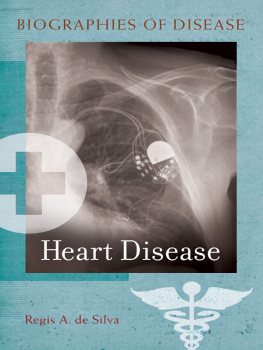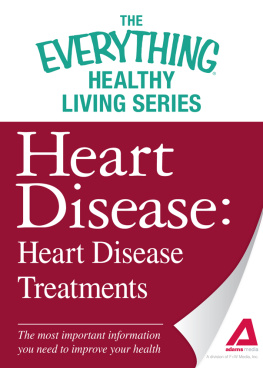Acknowledgments
I n writing this book, I owe a debt to several people. I wish to thank Professor Clifford Tabin, Chair of the Department of Genetics, Harvard Medical School; Dr. Deepak Srivastava, Wilma and Adeline Pirag Distinguished Professor of Pediatric and Developmental Cardiology and Director of the Gladstone Institute of Cardiovascular Disease, University of California, San Francisco; and Dr. James Lock, Alexander S. Nadas Professor of Pediatrics, Harvard Medical School and Cardiologist-in-Chief, Children's Hospital Medical Center, Boston. They were instrumental in providing useful information on specific aspects of new developments and treatments in cardiology.
Dr. Ernest Gervino, Associate Professor, Harvard Medical School and Director of the Exercise Stress Laboratory at Beth Israel Deaconess Medical Center, provided valuable input on exercise stress testing. Dr. Harvey Feigenbaum, Distinguished Professor, Indiana University School of Medicine, Indianapolis, provided me with information on the early history of echocardiography. Mr. Barouh V. Berkovits of Newton, Massachusetts, a senior engineer formerly at the American Optical Corporation and Medtronic Inc., and Igor F. Efimov, PhD, Lopata Distinguished Professor, Department of Biomedical Engineering, Washington University, St. Louis, Missouri alerted me to the early history of defibrillation in Russia. Dr. Karim Benali of Abiomed, Inc. of Danvers, Massachusetts, provided information on artificial hearts and ventricular assist devices. I also owe a debt of gratitude to Professor Bernard Lown, my mentor who gave me a start at Harvard and influenced my own interest and research in ventricular fibrillation. Mr. John C. Bogle of Vanguard's Bogle Financial Markets Research Center, Malvern, Pennsylvania, very kindly shared his medical history and heart transplantation experience with me. Any errors in interpretation of information and reporting are mine alone.
I also wish to thank Brendan Ozawa-de Silva, D. Phil., of Emory University, Atlanta, Georgia, for reading parts of the manuscript for clarity and flow for a nonmedical reader. Ms. Marta Vilas Zarauza of Santiago de Compostela, Spain, was my Spanish-speaking reader who helped read the manuscript for understanding by someone whose native language is not English.
Finally, I want to thank Mr. Michael Nobel, my editor, who raised the manuscript to a higher level with his useful suggestions and editorial expertise to turn it into a better book.
Dr. Regis A. DeSilva
Physician, Cardiovascular Division
Beth Israel Deaconess Medical Center
Associate Professor of Medicine
Harvard Medical School
Boston, Massachusetts
USA
About the Author
Dr. Regis A. DeSilva is associate professor of medicine at Harvard Medical School and a cardiologist at Beth Israel Deaconess Medical Center in Boston. After graduating from the Harvard Kennedy School of Government in 2004, he was director of Global Programs at Harvard Medical International, until 2011. Currently, he is also executive chairman of Global Medical Knowledge, Inc., which works in low-income and developing countries. He is, or has been, a Fellow of the Royal College of Physicians and Surgeons (Canada), a Fellow of the Royal Society of Medicine (United Kingdom), a Fellow of the American College of Cardiology, and president of the Boston Chapter of the American Heart Association. He lives in Cambridge, Massachusetts.
1
History of Cardiology

The poets did well to conjoin music and medicine in Apollo: because the office of medicine is but to tune this curious harp of man's body and to reduce it to harmony.
Francis Bacon (15611626)
In nearly all cultures, religion, magic, and healing have been inextricably intertwined. Healers were often seen as high priests or magicians, or a combination of both, privy to esoteric knowledge that they guarded jealously. Practitioners of the healing arts were not timid about invoking a higher authority to effect cures and to enhance their own power. They claimed to have special knowledge, and most of it was kept secret, though much knowledge about health and disease was largely erroneous. Such secrecy enhanced the power of the healer over the afflicted person, though it is likely that this power had the healing effect of a powerful placebo. Early medical practice was thus often clouded by a combination of various belief systems, religion, magical rituals, and even touches of Satanism.
In only a minority of cases did practitioners actually dissect bodies to examine diseased structures, or prepare themselves for their craft by studying human anatomy. In even fewer cases was there the study of physiology to understand the inner workings of the organs of the body. Many of the treatments prescribed were, therefore, unfounded on scientific logic.
Of all the internal organs, the mysteriously beating human heart has had the greatest emotional and mystical significance. In ancient times, the heart was believed to have spiritual and even divine attributes. Both the Old Testament (the Jewish Bible) and the Talmud make reference to the heart, which is referred to as lev or levav. There are anatomical descriptions of the heart in these texts that probably date from the fifth to the second centuries BCE. In the Upanishads, the Hindu texts that date back to about 300 BCE, the description of the heart includes its covering (the pericardium), proving recognition of its anatomical structure.
The persistence of esoteric knowledge related to bodily function and health is also seen in alchemy, astrology, anthroposophy, Christian Science, Theosophy, and Rosicrucianism. Even in more modern times, there are strong connections between religious beliefs and the heart. One such example is the cult of the Sacred Heart in French Catholic devotional life. Systematic studies of the heart and its physiological functions had to await the passage of several more centuries. The Renaissance, spanning from the 14th to the 17th centuries, began in Italy and spread to the rest of Europe. This movement saw a resurgence of artistic creativity and scientific investigation that opened the way for a systematic study of the heart and circulation.
EARLY CONCEPTS OF THE CIRCULATION
The ancient Egyptians did the first human anatomical examinations because anatomical dissection was essential to the practice of embalming the dead. In the third century BCE, Alexandria was the seat of Egyptian and Hellenistic culture, patronized by the pharaoh Ptolemy I Soter (367283 BCE). The establishment of a medical school in Alexandria further promoted the study of anatomy. However, despite the ancient Egyptians' apparently advanced medical and surgical knowledge, the role of the heart in the circulation of blood was not well understood at the time.
The discoveries of what are now known as the Edwin Smith Papyrus and the Ebers Papyrus were essential to our understanding of how the Egyptians studied anatomy and prescribed medical treatments. The Smith Papyrus, acquired by Edwin Smith in Thebes in 1862, is dated from around 30001600 BCE, or at least 1,200 years before Hippocrates. Some authorities believe it to be derived from the work of Imhotep, the first known physician. The Smith Papyrus deals largely with anatomy and surgical trauma but also correlates the pumping action of the heart with the pulse. This document describes the heart as being the center of a system from which all blood vessels radiate to the rest of the body.
The Ebers Papyrus, produced about 1550 BCE, or roughly 1,500 years after the Smith Papyrus, was acquired also in Thebes by the German Egyptologist Georg Ebers in 1872. The Ebers Papyrus is one of the most important early documents in medicine, and contains A Treatise on the Heart. This work also places the heart as the center of circulation and noted that it was attached to all major organs by blood vessels. The heart was therefore considered to be the center of the blood supply as it provided blood to the rest of the body. The circulatory system was also thought to carry other fluids such as urine, tears, and semen to the heart from other organs.







